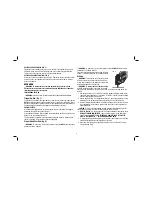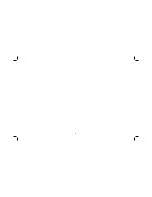
3
Additional Safety Instructions for Drills
• Wear ear protectors.
Exposure to noise can cause hearing loss.
• Use auxiliary handles supplied with the tool.
Loss of control can cause
personal injury.
• Hold power tool by insulated gripping surfaces only, when performing an
operation where the cutting accessory may contact hidden wiring or its
own cord.
Cutting accessory contacting a “live” wire may make exposed
metal parts of the power tool “live” and shock the operator.
• Use clamps or other practical way to secure and support the workpiece
to a stable platform.
Holding the work by hand or against your body is
unstable and may lead to loss of control.
• Wear safety goggles or other eye protection.
Drilling operations cause
chips to fly. Flying particles can cause permanent eye damage.
• Bits and tools get hot during operation.
Wear gloves when touching them.
• Keep handles dry, clean, free from oil and grease. it is recommended to
use rubber gloves.
This will enable better control of the tool.
WARNING: ALWAYS
use safety glasses. Everyday eyeglasses are NOT safety
glasses. Also use face or dust mask if cutting operation is dusty. ALWAYS WEAR
CERTIFIED SAFETY EQUIPMENT:
• ANSI Z87.1 eye protection (CAN/CSA Z94.3),
• ANSI S12.6 (S3.19) hearing protection,
• NIOSH/OSHA/MSHA respiratory protection.
WARNING:
Some dust created by power sanding, sawing, grinding, drilling, and
other construction activities contains chemicals known to cause cancer, birth defects
or other reproductive harm. Some examples of these chemicals are:
• lead from lead-based paints,
• crystalline silica from bricks and cement and other masonry products, and
• arsenic and chromium from chemically-treated lumber (CCA).
Your risk from these exposures varies, depending on how often you do this type of
work. To reduce your exposure to these chemicals: work in a well ventilated area, and
work with approved safety equipment, such as those dust masks that are specially
designed to filter out microscopic particles.
•
Avoid prolonged contact with dust from power sanding, sawing, grinding,
drilling, and other construction activities. Wear protective clothing and wash
exposed areas with soap and water.
Allowing dust to get into your mouth, eyes,
or lay on the skin may promote absorption of harmful chemicals.
WARNING:
Use of this tool can generate and/or disburse dust, which may cause
serious and permanent respiratory or other injury. Always use NIOSH/OSHA approved
respiratory protection appropriate for the dust exposure. Direct particles away from
face and body.
WARNING: ALWAYS wear proper personal hearing protection that conforms to
ANSI S12.6 (S3.19) during use.
Under some conditions and duration of use, noise
from this product may contribute to hearing loss.
WARNING:
We recommend the use of a residual current device with a residual
current rating of 30mA or less.
• The label on your tool may include the following symbols. The symbols and their
definitions are as follows:
V .................... volts
A ...............amperes
Hz .................. hertz
W ..............watts
min ................ minutes
...........alternating current
........... direct current
...........alternating or direct current
................. Class I Construction
no ..............no load speed
......................
(grounded)
.............earthing terminal
................. Class II Construction
.............safety alert symbol
......................
(double insulated)
BPM ..........beats per minute
…/min ........... per minute
RPM ..........revolutions per minute
Residual Risks
T he following risks are inherent to the use of drills:
– Injuries caused by touching the rotating parts or hot parts of the tool.
In spite of the application of the relevant safety regulations and the implementation of
safety devices, certain residual risks cannot be avoided. These are:
– Impairment of hearing .
– Risk of squeezing fingers when changing accessories.
– Health hazards caused by breathing dust developed when working in wood.
Summary of Contents for DWD024S-XE
Page 1: ...DWD024S XE VARIABLE SPEED REVERSIBLE PERCUSSION DRILL INSTRUCTION MANUAL ...
Page 2: ......
Page 11: ...9 ...






























